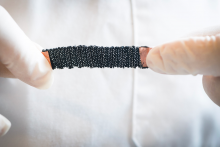Angelika Mader, UT researcher and the project leader, explains what WEAFING is all about. ‘We are developing a textile that contracts and will be used for clothes that talk to you – through touch. Having haptic stimulation interwoven directly in the fabric is very innovative. So far only vibration motors attached to the garment are used for such wearable technology. We do not use an extra actuator, the garment is the actuator itself.’
Navigation for blind people, sports, gaming…
‘Our very long-term goal is to use the textile for exoskeletons,’ continues Mader. ‘However, that requires a lot of force, and so in this project we are focusing on other applications.’ And there is a large number of those, according to the scientist.
Garments made of the smart fabric could be used by vision impaired people for navigation. Their clothing could allow them to ‘feel’ obstacles in the environment. The technology could further be applied in sports and physiotherapy, so that the clothing can give you feedback when learning new movements. In case of patients who need to lie in bed for a long time, the textile could help stimulate their blood circulation. Moreover, it could serve for social touch at distance and for haptic feedback in gaming.
Knitted muscles
‘Knitted muscles’ are at the core of it all. ‘To realize these garments we need several elements, but the basics are already there,’ says Mader. ‘Our partner Linköping University in Sweden has developed yarns from electroactive polymers that contract if you apply voltage. A UT alumnus is actually leading this development. To work properly, the yarns will need to be supported by a special gel, being developed at the University of Cergy-Pontoise, and then be woven into fabrics. University of Borås is looking into that part.’
Besides being the main coordinator of WEAFING, the University of Twente is doing research into the soft mechatronics of the desired garments. ‘We need to know what voltage and frequency is needed to actuate the “knitted muscles”. We need to find the right mechanics of how to apply pressure onto the skin,’ explains Angelika Mader. ‘On top of that, we are doing research on perception – what intensity and frequency of touch is optimal and at what places on the body.’
‘One of our challenges now is to increase the speed of contraction,’ says the project leader. ‘The textile currently doesn’t look very elegant, but we have more than four years to change that and we will.’ WEAFING will run until 2023 and should result in a ‘demonstrator garment’ fit for one of the many possible applications.
weafing
WEAFING is a Horizon2020 project and includes several European partners: University of Twente (coordinator), Linköpings Universitet (Sweden), Universite de Cergy-Pontoise (France), Högskolan i Borås (Sweden), Elitac Systems BV (the Netherlands), and Wearable Technologies AG (Germany).









